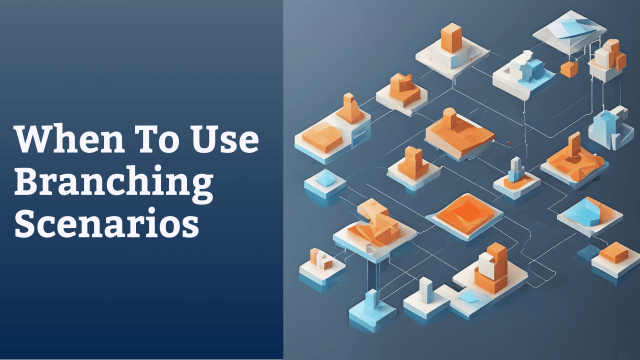When To Use Branching Scenarios
When should you use a branching scenario? Strategic skills that require nuanced decision-making and are risky to practice are a good fit.
Training methods are a bit like tools in a toolbox – you wouldn’t use a hammer to tighten a screw. So, when it comes to training, you might wonder, “When should you use a branching scenario rather than other training strategies?” There’s no one-size-fits-all answer. While I’m a big proponent of branching scenarios, they aren’t always the best method. To determine when to use branching scenarios, it’s important to make sure that approach aligns with your goals and is appropriate for the skill you’re training. Strategic skills that require nuanced decision-making and are risky to practice are good fits for branching scenarios.

Criteria for using branching scenarios or other approaches
Use these criteria as a starting point for considering when to use branching scenarios.
- Shades of Gray: The skill isn’t just black and white; there are nuances and shades of gray.
- Strategic: The skill is strategic rather than procedural; it requires more than a checklist.
- Multiple Decisions: The skill requires multiple coordinated decisions.
- Risky Situations: The skill is too risky to practice on the job.
Shades of gray, not just black and white
I find that branching scenarios work best for skills that are complex and include gray areas. If the steps are procedural, where there’s a clear list of actions to take in a specific order, a branching scenario is overkill.
Branching scenarios are most effective when they can show decisions that are partially correct or might be correct in certain circumstances.
This is reflected in the structure of the branching scenario, where you often have three choices: Best, OK, and Poor. In fact for very nuanced decisions, you might not even offer an overtly wrong choice. You could aim for “Good, Better, Best” as your three options, where everything is correct to some degree.
Alternatives in branching scenarios may also reflect trade-offs between different goals or values rather than being right or wrong. For example, in project management, you often have to balance time, cost, and quality.
Strategic, not procedural
Note: I use Amazon affiliate links to books I mention on my blog. It doesn’t cost you anything extra, but I get a little income to defray the cost of hosting this blog.
In her book Scenario-Based e-Learning: Evidence-Based Guidelines for Online Workforce Learning, Ruth Clark argues that scenario-based elearning, including branching scenarios and simulations, should be used for strategic tasks rather than procedural tasks. She explains:
Scenario-based e-learning is generally better suited to strategic tasks that require judgment and tailoring to each new workplace situation. Unlike procedures, strategic tasks cannot be decomposed into a series of invariant steps. Instead, strategic tasks require a deeper understanding of the concepts and rationale underlying performance in order to adapt task guidelines to diverse situations.
Multiple steps, not isolated decisions
Branching scenarios work best when the task requires multiple steps and decision points. You want situations where learners need to make several consecutive decisions or take several actions. Each decision affects the outcome and the choices available at the next step.
If you want learners to practice a single decision in isolation, where their choices don’t affect the subsequent actions, a single-question mini-scenario might be a better approach.
Risky situations, not safe to learn on the job
Some situations are dangerous to practice or learn on the job. Branching scenarios can give people opportunities to practice in a safe environment without risking injury. We don’t want people learning how to diagnose a problem with heavy construction equipment while they’re on the job and in a potentially hazardous situation. We want those mistakes made in a simulated environment.
Health care is another area where scenario-based learning can be effective because it gives people opportunities to practice diagnosing problems without affecting actual patients.
The consequences for other situations might also be so significant that they lend themselves to branching scenarios even without the risk of physical harm. What about sales people making a pitch to a CTO for a six-figure technology purchase? What about deciding how to ethically report data for a multi-million dollar research project? If the consequences are significant, more realistic practice through branching scenarios may help reduce major mistakes.
Your experiences
What are your experiences with branching scenarios? When do you find them helpful? When do you find them to be more trouble they’re worth? Share your experiences in the comments, or reply to this email.
If you’re looking for more, check out When Should You Avoid Branching Scenarios?
Originally published 7/17/2018. Updated 10/12/2023.
6 thoughts on “When To Use Branching Scenarios”